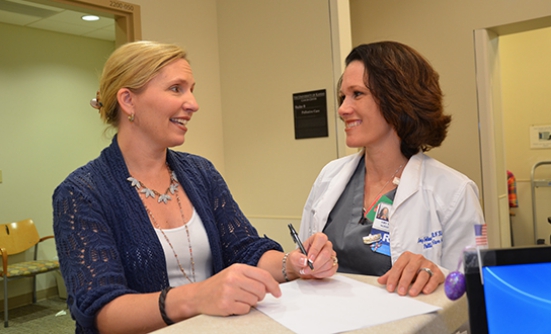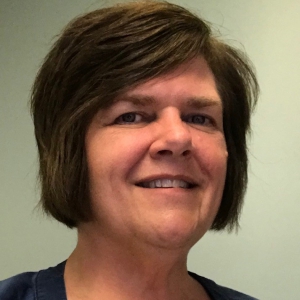There we sat. A hush had come over the room as the information received was processed. So much detail. So many decisions. Jay finally surveyed the room, broke the silence, and asked, “How do you expect me to make this decision? I have never been through this before. You people are the experts. Tell me what to do.”
The first part of Jay’s visit with the medical oncologist focused on understanding who Jay was as a person—what brought him pleasure in his everyday life, did he still work, what occupied his free time, what were his hobbies and entertainment, and who was important to him, as well as who would be accompanying him. From there, the medical oncologist delved into Jay’s medical history, learning how he and his family wished to receive health information, and what he already knew and understood about his diagnosis.
The conversation switched from information gathering and inquiry to one of fact sharing and educating. Jay and his family sat with the medical oncologist for nearly an hour reviewing his cancer diagnosis in great detail—the type of cancer, stage of cancer, treatments available for the cancer, and the benefits as well as risks associated with each treatment. After fully disclosing all known details, his medical oncologist sought to understand what Jay wanted to get out of his treatment and to determine what side effects he was willing to accept for a proposed 5% to 10% “added survival benefit.”
Fortunately, long gone is the day where the doctor walks into the room and truly tells healthcare consumers what to do when it comes to their health and treatments. In 2001, the Institute of Medicine released recommendations for improving the overall quality of healthcare, and in so doing identified patient-centered care as the pinnacle to providing high-quality cancer care. Patient-centered care is defined as “providing care that is respectful of and responsive to individual patient preferences, needs, and values, and ensuring that patient values guide all clinical decisions.”1 A growing body of evidence reveals that people who are actively involved in their healthcare decision-making process stick to their treatment plans, experience better health outcomes, and incur lower healthcare costs.2 As a result, many healthcare organizations are using approaches engaging patients in making decisions about their care.
Patient-centered care encourages open communication between patients and their healthcare team. A key component of patient-centered healthcare is shared decision-making—a process in which doctors and patients work together to weigh clinical information against the risks and expected outcomes with patient preferences and values. It is extremely important when there are multiple options for treatment but no single “right choice” exists, because the balance between benefits and risks affect individuals differently.3
Reaching the best healthcare decision through shared decision-making involves both parties sharing information—the physician discussing treatment options and describing the benefits and risks associated with each, and you, the patient, clearly expressing your preferences and values. This “getting to know you” gives members of your healthcare team an opportunity to learn what is important to you, what goals you may have set for yourself, what compromises you may be willing to make, what are considered hard stops, and what you value most. For some, it may be length of life regardless of cost, whether it be physical, emotional, financial, or practical cost. For others, quality of life over quantity fits best. Each decision you make extends beyond the here and now in relation to your health and treatment options. It encompasses your family, treatment effects to work, home life, and your role within your family, and, ultimately, whether it meets your needs and goals.
For some, participating in cancer treatment decisions may be uncomfortable, because you don’t think you know much about cancer, and the words the healthcare team uses seem like a foreign language. It may be you are feeling overwhelmed and stressed, or physically you do not think you can make a good decision. Be that as it may, you need to understand the critical part you play in the shared decision-making process. Certain treatment decisions are straightforward with only 1 clear answer (eg, pneumonia requiring antibiotics and chronic obstructive pulmonary disease exacerbation requiring steroids). But sometimes there is more than 1 sensible option, including different combinations of benefits and side effects, such as starting chemotherapy for advanced cancer when there are no symptoms being caused by the cancer but knowing there is a high chance of nausea or infection, or waiting for biomarkers to determine if there is a pill to take daily at home versus chemotherapy given in an infusion center every couple weeks (depending on cancer, stage, and “recipe” selected).
Why is shared decision-making so important in treatment planning? Personal control. Peace of mind. Satisfaction with treatment path. Improved outcomes. How do you take so much information, break it down in such a way that you can wrap your mind around all the choices and select the one best treatment option? With all the talk about patient-centered care and shared decision-making, where do you start? Shared decision-making is a simple 3-step process involving information exchange, conversation, and decision agreement.3
Steps for shared decision- making include:
- Information Exchange: During this interchange of information, it may be to your advantage to have family members or a trusted friend accompany you to your appointments. Extra sets of ears work better than one. Make sure you either leave with written understandable notes from the visit or ask if you can record the session. When it comes time to make a final decision, you will want to have as much information as possible.
- Listen intently on the evidence-based detailed information coming from the provider; focus on details of the diagnosis and treatment options available
- Ask questions and keep asking until you fully understand your options, the impact each option may have on you and your current lifestyle, and what needs to be considered before committing to the treatment plan
- Identify the decision you are being asked to make
- Openly share with your provider what is important to you
- What do you hope treatment will do for you
- What important milestones are you wishing to be a part of short-term (vacation the next month) and long-term (attending a grandchild’s graduation in June)
- What worries you most about the treatment options presented
- Conversation: This is the time to gather all of the necessary details about the options available, determine if there are clear-cut differences between them, and how the benefits and risks associated with each option will affect you.
- Make a list of the options presented along with the benefits and risks associated with each of them
- Ask for clarification if your provider shares information you are not familiar with so you have a clearer understanding
- Determine which of the options provides the most benefit that matters to you, and identify the options you wish to avoid
- Ask if there is a disease-specific decision support tool to help you organize the options and think through the benefits and risks associated with them
- Decision Agreement: During this time, you will need to be able to commit to the treatment path you are willing to undergo. If there are still more questions or uncertainties, postpone making the decision until you feel comfortable. Make sure you and your provider agree on a time frame when the final decision must be made. You do not want to compromise the value of the treatment options by delaying the decision.
- Remember what is most important to you when making this decision
- Take time to bounce your thoughts off your family. Seek input from loved ones, but know you are in charge of this journey. Having a sounding board also provides you with insight as to the reality of your expectations
So, what about Jay? His medical oncologist reviewed what Jay had shared with us at the beginning of his appointment. Jay wanted to continue to volunteer and spend quality time with his family. His family shared he had a big appetite, both for life and for food. It was important to him to be able to continue working in his wood shop, where he makes wooden clocks, and he needs to have the dexterity to put together the intricate workings of the clock faces. Going to the cabin during hunting season was essential, and having the stamina to “pull the deer from the deep woods” was equally necessary. He verbalized his understanding that the chemotherapy was going to increase his chance of progression-free survival by 5% over 5 years. He understood he was at a higher risk of numbness and tingling in his fingers, toes, and feet because of his diabetes and preexisting neuropathy. He acknowledged the possibility of changes to his sense of taste and/or appetite. Due to the impact chemotherapy will have on his goals of care (quality of life), Jay opted to proceed with surveillance of his cancer every 6 months with CT scans and office visits and declined the 4 cycles of chemotherapy.
Whenever you arrive at a crossroad of treatment options, where separate paths have different consequences with lasting implications, take pause, gather all of the facts, and ask yourself what is most important to you now, and how it aligns with your goals and wishes. Then with confidence, grab a seat at the table and meet with your healthcare team to define the road best suited for you…one more time.
References
- Institute of Medicine. Crossing the Quality Chasm: A New Health System for the 21st Century. Washington, DC: National Academies Press; 2001.
- Veroff D, Marr A, Wennberg DE. Enhanced support for shared decision making reduced costs of care for patients with preference-sensitive conditions. Health Aff (Millwood). 2013;32:285-293.
- Elwyn G, Frosch D, Thompson R, et al. Shared decision making: a model for clinical practice. J Gen Intern Med. 2012;27:1361-1367.













